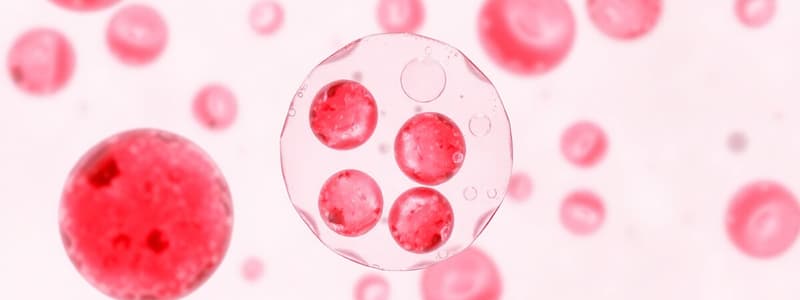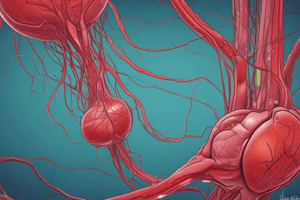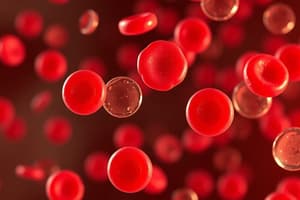Podcast
Questions and Answers
Which of the following substances increases platelet adhesiveness?
Which of the following substances increases platelet adhesiveness?
- Epinephrine
- Thrombin
- ADP (correct)
- Serotonin
Platelets require a longer time period to adhere to sites of vascular damage compared to erythrocytes.
Platelets require a longer time period to adhere to sites of vascular damage compared to erythrocytes.
False (B)
What type of proteins are actomycin, myosin, and filamin considered?
What type of proteins are actomycin, myosin, and filamin considered?
Contractile proteins
The primary role of platelets in hemostasis includes adhesion and aggregation forming the _____ hemostatic plug.
The primary role of platelets in hemostasis includes adhesion and aggregation forming the _____ hemostatic plug.
Which of these components are involved in the recruitment of local platelets during aggregation?
Which of these components are involved in the recruitment of local platelets during aggregation?
Match the following agents with their roles in platelet aggregation:
Match the following agents with their roles in platelet aggregation:
Platelet aggregation is a passive process and does not require energy.
Platelet aggregation is a passive process and does not require energy.
What is the term for the transformation of platelets from a disc to a sphere, which aids in their function?
What is the term for the transformation of platelets from a disc to a sphere, which aids in their function?
What is the primary function of thrombopoietin in the body?
What is the primary function of thrombopoietin in the body?
Platelets have a normal lifespan of 14-21 days.
Platelets have a normal lifespan of 14-21 days.
From which type of cell do megakaryocytes arise?
From which type of cell do megakaryocytes arise?
Each megakaryocyte can give rise to approximately _____ platelets.
Each megakaryocyte can give rise to approximately _____ platelets.
Match the following terms with their definitions:
Match the following terms with their definitions:
During which process does the megakaryocyte enlarge its cytoplasmic volume?
During which process does the megakaryocyte enlarge its cytoplasmic volume?
The normal platelet count ranges from 100,000 to 300,000 cells/uL.
The normal platelet count ranges from 100,000 to 300,000 cells/uL.
What is the average size range of a platelet?
What is the average size range of a platelet?
What is the primary function of glycoprotein receptors in the glycocalyx?
What is the primary function of glycoprotein receptors in the glycocalyx?
The granules within mature platelets include only alpha granules and lysosomes.
The granules within mature platelets include only alpha granules and lysosomes.
What do canaliculi in platelets facilitate?
What do canaliculi in platelets facilitate?
The external coat of a platelet that consists of plasma proteins and carbohydrates is known as the ______.
The external coat of a platelet that consists of plasma proteins and carbohydrates is known as the ______.
Match the following types of granules with their contents:
Match the following types of granules with their contents:
Which component directly maintains the discoid shape of the platelet?
Which component directly maintains the discoid shape of the platelet?
Dense bodies in platelets contain ADP, ATP, and calcium.
Dense bodies in platelets contain ADP, ATP, and calcium.
The primary role of the ______ in platelets is to mediate contact reactions and assist in aggregation.
The primary role of the ______ in platelets is to mediate contact reactions and assist in aggregation.
What is true about the degree of clot retraction?
What is true about the degree of clot retraction?
Clot retraction is inversely proportional to the number of platelets.
Clot retraction is inversely proportional to the number of platelets.
What substance is known to induce a long-lasting functional defect in platelets, detectable as a prolongation of the bleeding time?
What substance is known to induce a long-lasting functional defect in platelets, detectable as a prolongation of the bleeding time?
A thrombus is defined as a platelet aggregate reinforced by fibrin.
A thrombus is defined as a platelet aggregate reinforced by fibrin.
Name one agent that can be used to aggregate platelets.
Name one agent that can be used to aggregate platelets.
The process of dissolved fibrin clot is known as _____ .
The process of dissolved fibrin clot is known as _____ .
How can the quantitative determination of platelets be assessed?
How can the quantitative determination of platelets be assessed?
A prolonged bleeding time, despite a normal platelet count, suggests _____ platelet function.
A prolonged bleeding time, despite a normal platelet count, suggests _____ platelet function.
Which method can be used to analyze platelet adhesion in vitro?
Which method can be used to analyze platelet adhesion in vitro?
Antiplatelet antibodies can be demonstrated in cases of immune thrombocytopenia.
Antiplatelet antibodies can be demonstrated in cases of immune thrombocytopenia.
What is the normal range of platelets visible in a properly prepared blood smear?
What is the normal range of platelets visible in a properly prepared blood smear?
Bleeding time is an in vivo measurement of platelet adhesion and aggregation on injured vascular subendothelium.
Bleeding time is an in vivo measurement of platelet adhesion and aggregation on injured vascular subendothelium.
What type of plasma is treated with aggregating agents to assess platelet function?
What type of plasma is treated with aggregating agents to assess platelet function?
Match the following terms with their definitions:
Match the following terms with their definitions:
What does clot retraction indicate?
What does clot retraction indicate?
Match the components with their corresponding effects:
Match the components with their corresponding effects:
Flashcards are hidden until you start studying
Study Notes
Thrombopoiesis and Platelet Structure
- Platelets (2-4 μm in diameter; larger in disease) are cytoplasmic fragments from megakaryocytes.
- Megakaryocytes, the largest bone marrow cells, can reach up to 160 μm in size and have high ploidy values (4n, 8n, 16n, 32n).
- Thrombopoietin, produced by the liver and kidneys, regulates platelet production, with an average production time of 10 days.
- Normal platelet count ranges from 150,000 to 450,000 cells/μL, with a lifespan of 7-10 days.
Platelet Development
- Megakaryoblasts differentiate from hematopoietic stem cells to form megakaryocytes through synchronous endoreduplication.
- Each megakaryocyte produces approximately 1,000-5,000 platelets.
- Under normal circumstances, up to one-third of platelet production is trapped in the spleen, increasing to 90% during splenomegaly.
Platelet Morphology and Function
- Inactively circulating platelets have a discoid shape maintained by a microtubular cytoskeleton.
- The external glycocalyx contains plasma proteins and glycoprotein receptors essential for platelet adhesion and aggregation.
- Platelets possess a canalicular system for transporting clotting factors, facilitating secretion of granule contents during activation.
Granules in Platelets
- Platelets contain three types of granules: alpha granules, dense granules, and lysosomes.
- Alpha granules store factors like platelet-derived growth factor, fibrinogen, and von Willebrand factor.
- Dense granules contain serotonin, ADP, ATP, and calcium; lysosomes hold hydrolase enzymes.
- Release of granule contents occurs through internal contraction and is essential for hemostasis.
Hemostasis Functions
- Platelets play a critical role in hemostasis by forming a primary plug, releasing procoagulant molecules, and providing a surface for coagulation reactions.
- Platelet adhesion occurs within 1-2 minutes post-vessel injury, aided by ADP which increases adhesiveness.
- Glycoprotein IIb/IIIa receptors mediate interaction with fibrinogen, facilitating platelet cohesion.
Platelet Aggregation
- A multistep process involving distinct receptors and ligands occurs during platelet aggregation, influenced by blood flow conditions.
- Aggregation can be triggered by collagen, thrombin, and other agents.
- Aggregates reinforced by fibrin become thrombi; aspirin can lead to prolonged bleeding time by inhibiting aggregation.
Laboratory Assessment of Platelets
- Quantitative platelet determination can be achieved through electronic counters or manual methods, estimating normal levels based on microscopy.
- Qualitative assessment is necessary if bleeding history suggests normal platelet counts.
- Bleeding time indicates platelet functionality and integrity, increasing significantly below certain platelet thresholds.
Additional Platelet Tests
- Clot retraction reflects platelet number and quality, fibrinogen levels, and hematocrit.
- Aggregation tests using agents like thrombin measure the platelet-rich plasma's cloudiness to evaluate function.
- Antiplatelet antibody assays may detect antibodies against platelets, particularly in immune thrombocytopenia cases.
Studying That Suits You
Use AI to generate personalized quizzes and flashcards to suit your learning preferences.




